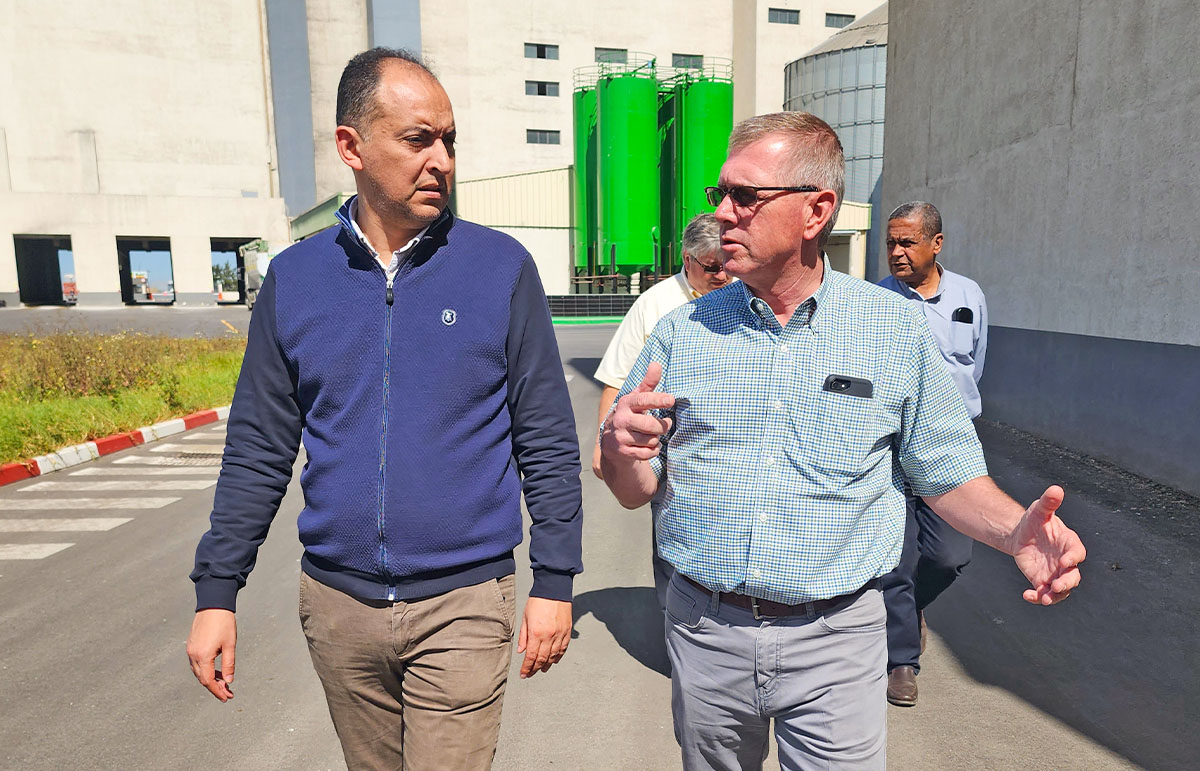
Randy Miller chats with Eddik Feed Technical Director Yassir Aruri (Photo: Aaron Putze/Iowa Soybean Association)
Inflation spikes, global currency devaluations curb U.S. soybean sales
June 1, 2023 | Aaron Putze, APR
It’s often said that when the U.S. economy sneezes, the rest of the world catches a cold.
Now, it comes with the flu, too.
“What happens economically in the U.S. doesn’t stay in the U.S.,” says Iowa Soybean Association (ISA) President Randy Miller. “Fiscal policies and elections have an impact, especially for people in developing countries.”
Miller’s observation comes after traveling to Morocco and Egypt on an ISA-led trade mission. The farmer from Lacona and ISA President-Elect Suzanne Shirbroun from Farmersburg conversed with Egyptian and Moroccan feed millers, farmers and farm advocates during a two-week visit in March.
The goal: To increase the price paid to Iowa farmers for the soybeans they grow by boosting preference and demand for the oilseed among developing countries.
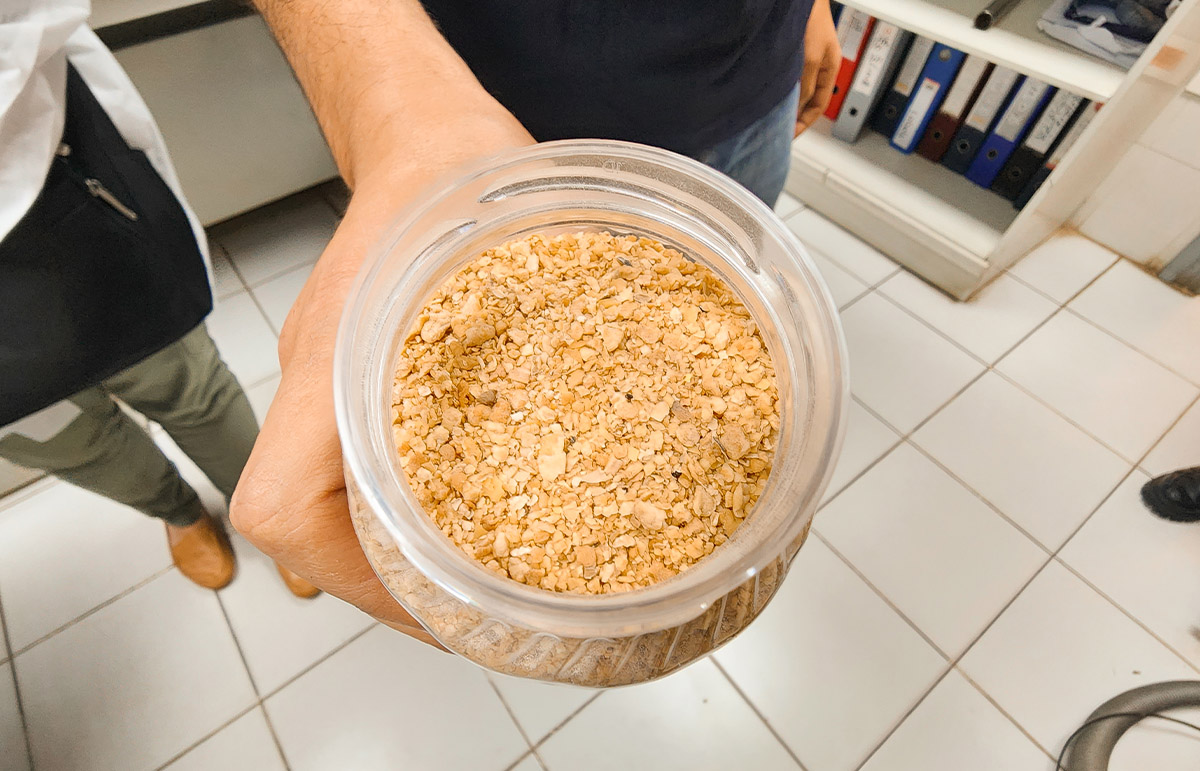
“Egypt and Morocco are becoming more urbanized, and they want to eat more protein,” Miller says. “That bodes well for more soybean demand.”
But being a reliable supplier of soy isn’t enough. It must be competitively priced, too.
“The state of financial affairs, both in the U.S. and globally, is on everyone’s mind,” adds Shirbroun. “It’s the start of every conversation and answer to every question.”
Hard hit
The Egyptian people have been walloped by the rising value of the U.S. dollar. Interest rate hikes by the U.S. Federal Reserve have depressed the buying power of the Egyptian pound.
Case in point: It takes almost twice the number of Egyptian pounds to purchase each U.S. dollar of agricultural products than it did just one year ago.
Put another way, Egyptian buyers must pay nearly twice the amount for a metric ton of U.S. soybean meal. In turn, the cost of producing eggs, milk, fish and poultry is accelerated for a key U.S. trading partner. The higher costs are passed along to Egyptian consumers already struggling with soaring cost-of-living expenses, including energy.
“What was a difficult situation has become a dire one for people living on the edge,” Miller says. “It’s heartbreaking because you know the important role soy plays, yet there aren’t any easy levers to pull to improve the situation.”
Skretting, a feed miller located about a 90-minute drive outside of downtown Cairo, knows all too well the headwinds created by soaring U.S. interest rates and the Egyptian pound’s plummeting value.
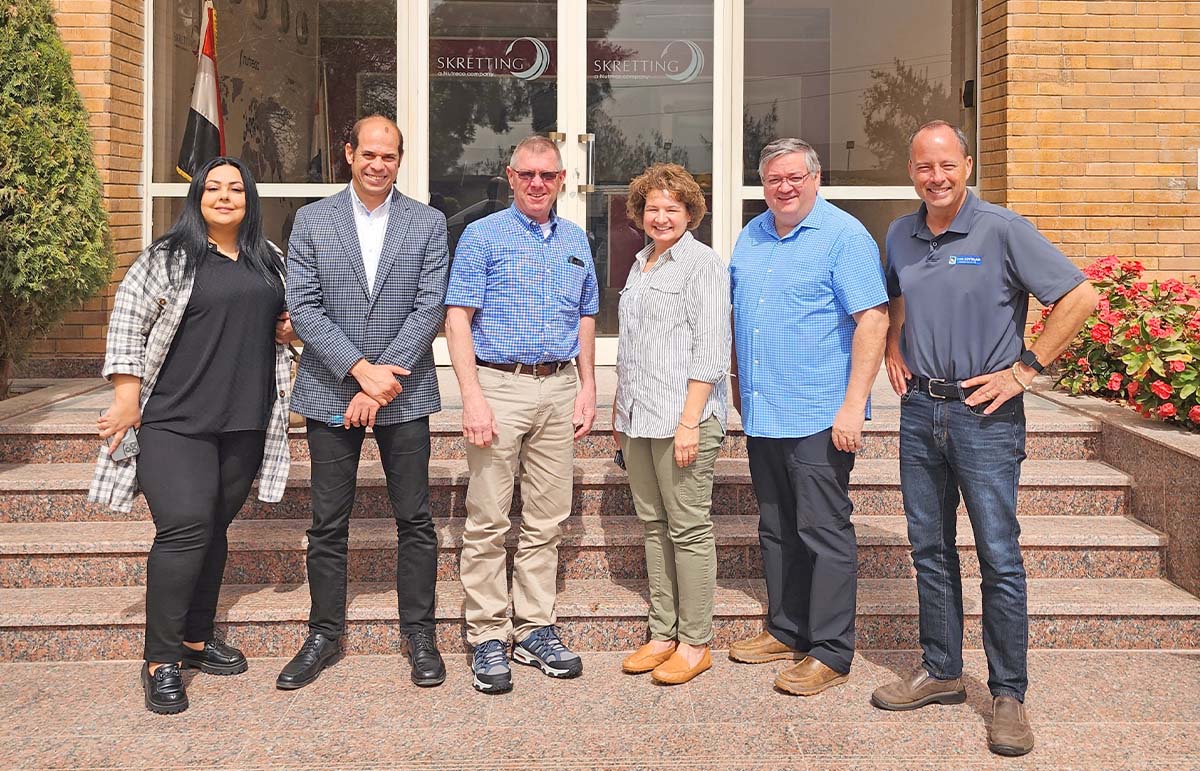
“The first question you get asked when visiting with soybean buyers in Egypt is where are interest rates going?” says Shirbroun. “The cost of everything is top of mind as companies seek to source raw commodities for feed.”
Dutch-based Nutreco Co., of which Skretting is a subsidiary, is a top-five global producer of feed, vitamins, mixes and additives. The family company was founded in 1896 and specializes in health, nutrition and food production. It’s the world’s top producer of aquafeed, with a workforce of more than 55,000.
Shirbroun says increased population, changing diets, growing urbanization and a rising middle class are top-of-mind for companies like Skretting. The combination generates an insatiable appetite for U.S. soybean meal.
Skretting operates in 18 countries, producing 3 million tons of fish and shrimp feed annually. It also operates aquafeed research and validation stations in nine countries. Its Egypt facility accounts for 1.6 million tons of aquafeed annually. In 2008, the company added aquafeed to its line of animal feed. Production and feed efficiencies have improved dramatically.
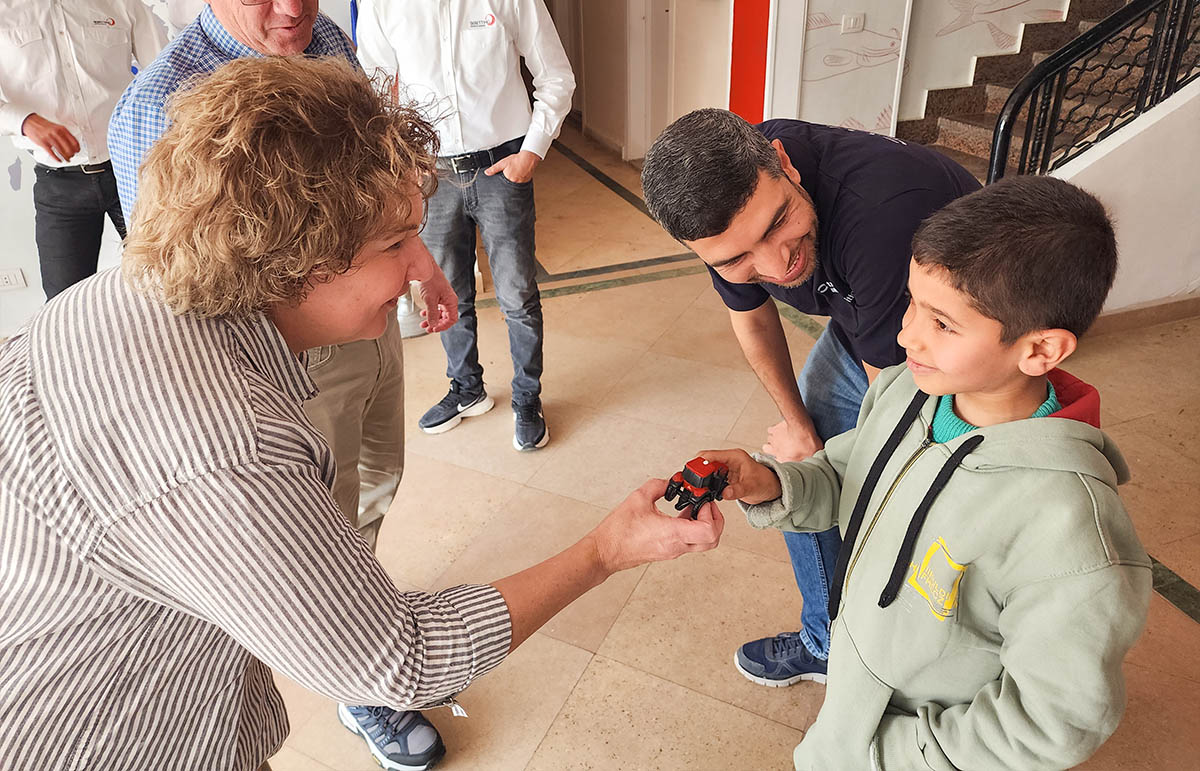
Raw materials like soy are an essential slice of its production pie, says Dr. Alaa Badr, production manager for Skretting’s Egyptian production facility.
“We must create the right formulations for best feed conversions depending on the species type,” says Badr. “There’s no ambiguity about the goal. U.S. soy is a big part of achieving it.”
Better feed
Soy, he says, is an essential ingredient in making better feed. And better feed means a better product for consumers.
But the sudden and rapid escalation in U.S. soy prices is causing buyers like Skretting to search for less expensive ingredients, like barley. The result: a downturn in soybean sales to Egypt.
Three years ago, Egypt sourced 4.2 million metric tons of U.S. soy. Thus far this marketing year, sales are off by more than 80%.
“We want to buy U.S. soy, but it’s too expensive now,” says Badr. “At these prices, the supply chain is broken.”
Everyone, he adds, is impacted when the cost of feed ingredients soars, from U.S. and Egyptian farmers to Egyptian feed manufacturers, food processors and consumers.
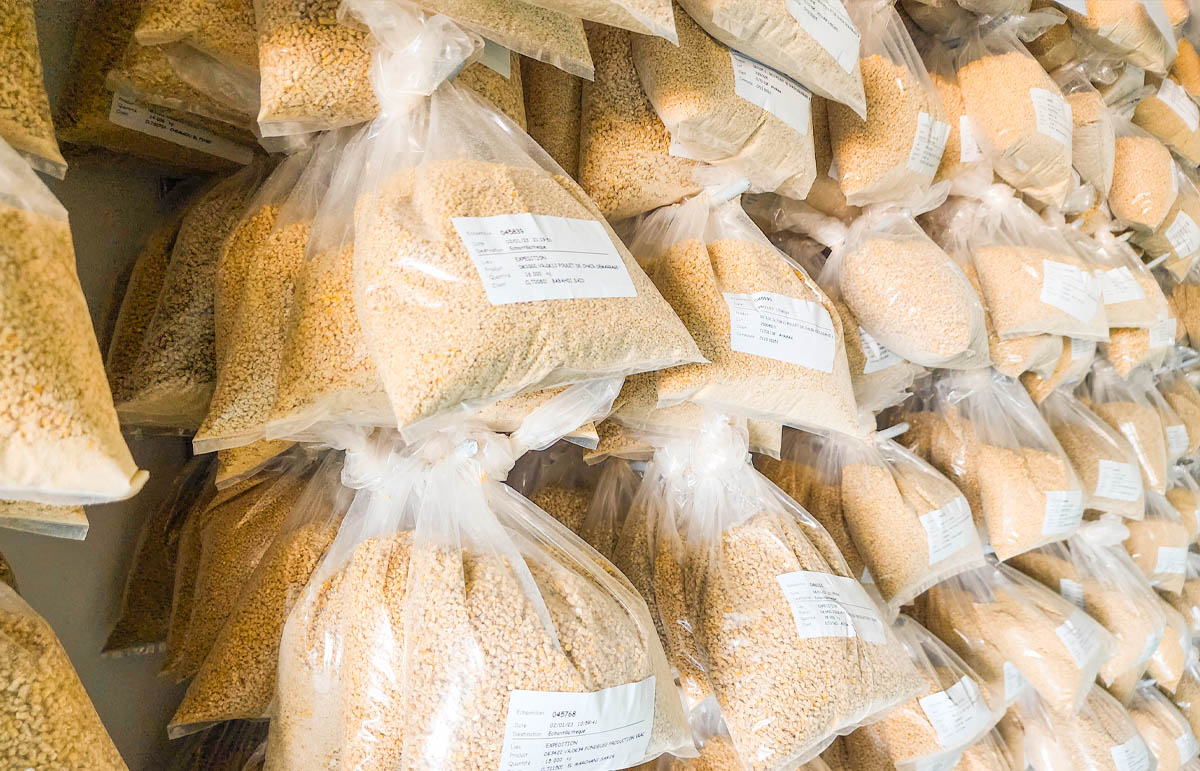
Russia’s continued war with Ukraine doesn’t help, as it drives up the price of corn and wheat.
“It’s like someone stole your wallet,” Badr says. “Everyone is suffering.”
While the Moroccan economy is more stable than its neighbor to the east, the country still faces its share of financial headwinds. Home to 38 million people, Morocco’s unemployment rate stands at 11%, while inflation has soared to 8.3% (up from 1.3% in 2022).
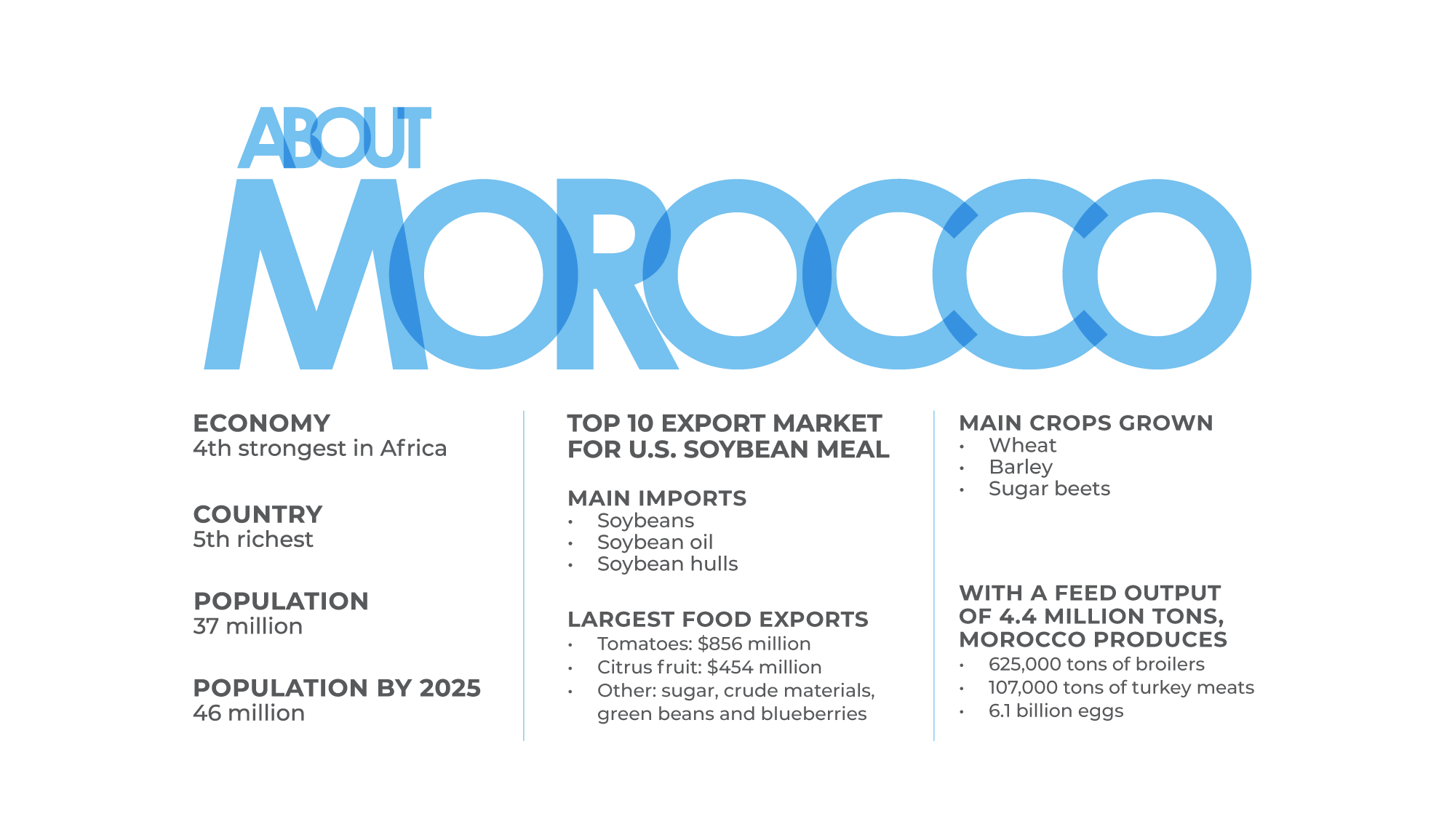
Eddik Feed, located 25 miles south of Casablanca near Berrechid, supplies the poultry, dairy and broiler industries. Before COVID-19’s arrival in 2020, annual poultry and egg consumption were increasing by 6% and 7%, respectively. Feed production was also surging — up more than 20%.
Like Skretting, the economic tsunami of COVID, Russia’s war in Ukraine and the stronger U.S. dollar has created turmoil in the feed business. And that directly impacts the fortunes of U.S. soybean farmers.
In 2018, Eddik invested $35 million in the construction of a new feed mill with a production capacity of 30,000 metric tons per month. Like other Moroccan millers, Eddik buys soybean meal from the U.S. because of its quality and reliability. This preference has helped the U.S. soybean industry amass a 60% market share in the country of 37 million.
But those volumes will take a hit this year as consumer purchasing power and poultry production wane.
“The market has decreased, and it’s not a good period to start projects,” says Yassir Aruri, Eddik’s technical director.
Future unknown
Founded in 1978, the company operates six milling plants in a country that ranks inside the top 10 in U.S. soybean importers. Last year, Eddik Feed imported 80% of its total soybean meal purchases, 175,000 metric tons.
This year?
“We don’t know as so much depends on price and right now, prices are very high,” says Aruri.
Despite the current tough sledding, Badr of Skretting in Egypt remains optimistic the economy will improve. And when it does, there will be a need for more fish and shrimp in the retail market.
“Better management, better feed quality and better consumer demand will help farmers squeeze out a profit, maybe yet this year,” Badr says. “And that bodes well for everyone.”
Shirbroun agrees.
“There are ample soybean supplies but a lack of access to U.S. dollars to make purchases,” she says.
“The raw materials are there; it’s how do we make the financial system work so the raw product can move?”
The Soy Checkoff: A market builder
Almost 15 years ago, the U.S. Soybean Export Council (USSEC), supported by checkoff investments of Iowa soybean farmers and constructed floating cage systems for tilapia production in developing countries. By 2017, the system evolved into an Inland Pond Raceway System (IPRS). The new way to produce fish more efficiently and sustainably was quick to catch on. A key piece of the IPRS is the need for increased quantities of soy-based feed. In 2019, Skretting team members participated in a USSEC Soy Excellence Center program to become more knowledgeable about IPRS, soy-based feed formulations and production techniques for shrimp. As a result, shrimp production is expanding along with Egypt’s need for U.S. soybean meal.
Back